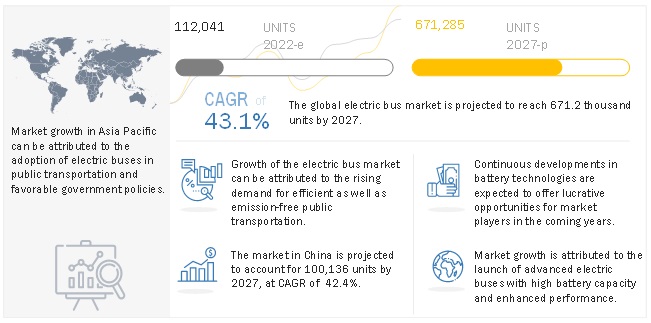Electric Bus Market worth 671,285 units by 2027
The global Electric Bus Market size is expected to grow from approximately 81 thousand units in 2021 to reach 704 thousand units by 2027, at a CAGR of 43.1%. Factors such as rise in pollution and environmental hazards, stringent government regulations, and stiff competition have compelled automotive OEMs to make fuel-efficient and environment-friendly vehicles.
OEMs worldwide are investing heavily in research & testing applications leading to continuous advancements in electric buses. For instance, in September 2020, Proterra introduced its newest battery-electric transit vehicle, ZX5 electric bus. The Proterra’s fifth-generation battery-electric transit bus features a new streamlined vehicle design and maximizes the amount of energy that can be stored onboard the vehicle to increase power and range. Also, in September 2020, Mercedes-Benz unveiled the new all-electric eCitaro G. It is optionally equipped with innovative solid-state batteries.
Download PDF Brochure @ https://www.marketsandmarkets.com/pdfdownloadNew.asp?id=38730372
In the Electric Bus Market, by length of bus, the 9–14 m segment is projected to be the largest market during the forecast period in terms of volume. The 9–14 m segment is dominating the electric bus segment due to the large volumes of electric passenger buses used in public transport fleet. Most of the public transport fleets, especially in China, which accounts for more than 93% of the market have most of electric buses that are 9–14 m in length. Also, many of the leading OEMs such as BYD, Proterra, and Yutong have been providing electric buses in the 9–14 m length range. Countries that are planning to replace existing public fleets with electric ones are considering electric buses of the same lengths as well.
The Electric Bus Market leaders are focusing on expanding their businesses in new markets across the world. North America is one of the potential markets for electric buses and coaches. In October 2020, New Flyer of America Inc., a subsidiary of NFI Group Inc. announced that Knoxville Area Transit (“KAT”) has awarded New Flyer a contract for twelve zero-emission, battery-electric thirty five-foot heavy-duty transit buses, with options to purchase up to 13 additional zero-emission buses in thirty-five or forty-foot lengths throughout the remaining term of the five-year agreement OEMs are launching new variants of electric buses for the use of school buses. For instance, in March 2021, the Blue Bird has delivered its 400th electric school bus in North America. The company expects to have 1,000 electric school buses delivered by 2022. These buses are mainly used for electric bus purpose, and plans to move toward zero- emissions school buses. Yutong has also become the first full electric bus brand represented in Denmark and is also the first Chinese bus brand with sizable volume in Denmark.
The up to 400 kWh segment is estimated to have the largest market in 2021 due to the large volumes of electric buses in Chinese intracity public transport. Most buses use up to 400 kWh batteries. A major advantage of the up to 400 kWh battery is fast charging at a low price and high energy efficiency. As a result, major players have deployed up to 400 kWh of battery capacity to stay in the competition. Also, up to 400 kWh batteries are cheaper and require less space, and thus, the segment is expected to lead the market during the forecast period.
The up to 250 KW segment is dominating the Electric Bus Market due to the large volumes of electric passenger buses used in public transport fleet. Most public transport fleets, especially in China, have electric buses with a power output of up to 250 kW. Toyota’s fuel cell bus ‘Sora’ powertrain consists of two 114 kW fuel cell stacks developed for Toyota Mirai. Currently, many fuel cell buses in Europe use hybrid fuel cell technology. For instance, the Van Hool A330 bus ordered for Cologne and Wuppertal cities in Germany in July 2019 had a fuel cell stack of 85 kW supplied by Ballard Power Systems and a 24-kWh traction battery. With continuous developments in electric vehicle technologies, high-powered electric buses are expected to grow in the future as well.
The Asia Pacific region is the largest Electric Bus Market in the world. It comprises some of the fastest developing and developed economies in the world. The growth in the region can be attributed to the dominance of the Chinese market and the presence of leading OEMs such as BYD and Yutong in the country, resulting in the exponential growth of the electric bus and coach market in Asia Pacific. Also, Shenzhen was the first city in the world to have a fully electrified public transport fleet. The large volumes of electric bus production, favorable regulations for electric buses, and rapidly growing charging infrastructure are projected to boost the Asia Pacific Electric Bus Market.
Request Free Sample Report @ https://www.marketsandmarkets.com/requestsampleNew.asp?id=38730372
Media Contact
Company Name: MarketsandMarkets™ Research Private Ltd.
Contact Person: Mr. Aashish Mehra
Email: Send Email
Phone: 18886006441
Address:630 Dundee Road Suite 430
City: Northbrook
State: IL 60062
Country: United States
Website: https://www.marketsandmarkets.com/Market-Reports/electric-bus-market-38730372.html



